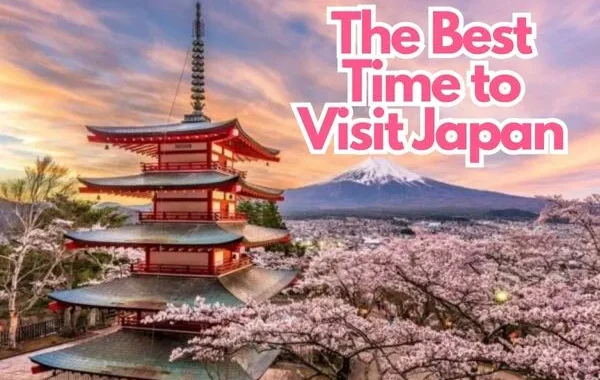Planning a trip to Japan is an exciting adventure, but timing is everything! Visiting at the right time of year can make all the difference in terms of weather, crowds, and unique experiences. In this guide, we’ll explore the best time to visit Japan and what makes each season special.
Japan is a country with distinct seasons, and each one offers a unique experience for visitors. Timing a trip to Japan can make or break the success of your vacation. Here’s why:
- Weather: Japan’s climate is varied and can be unpredictable. Depending on the season, you can experience anything from snowstorms to typhoons. Choosing the right time of year for your trip can help you avoid extreme weather conditions and enjoy comfortable temperatures.
- Crowds: Japan is a popular tourist destination, and certain times of the year can be very crowded. Traveling during peak season means bigger crowds and higher prices, while off-season travel can be quieter and less expensive.
- Events and Attractions: Japan has unique cultural events and attractions that are specific to certain seasons. Timing your trip around these events can give you a more authentic and memorable experience.
The Best Time to Visit Japan – Season by Season
Japan has four distinct seasons, and each one offers something special for visitors. Here’s an overview of what to expect in each season:
- Spring: From March to May, Japan’s cherry blossoms bloom, creating a stunning sea of pink across the country. Spring is a popular time to visit Japan, but it can be crowded.
- Summer: June to August is Japan’s summer season, and it’s a great time to experience Japan’s lively festivals and outdoor activities. However, the weather can be hot and humid, and crowds can be heavy.
- Fall: September to November is when Japan’s autumn leaves turn vibrant shades of red and orange. The cooler temperatures make it a comfortable time to travel, and there are plenty of cultural festivals to enjoy.
- Winter: December to February is Japan’s winter season, and it’s an excellent time to experience Japan’s snow festivals and winter sports. The weather can be cold, but there are fewer crowds and lower prices.
Now that you know why timing is everything in Japan and what to expect in each season, let’s dive deeper into each one. In the following sections, we’ll explore the best time to visit Japan in more detail and provide tips and recommendations for each season. First up, let’s explore the magic of Japan in the springtime!
1. Spring (March to May): The Best Time to Visit Japan for Cherry Blossoms
Spring is a magical time to visit Japan, as the cherry blossoms bloom and create a beautiful sea of pink across the country. Here’s what you need to know about visiting Japan during spring:

Experience the Magic of Cherry Blossom Season in Japan
- When to Visit: The cherry blossoms typically bloom from late March to early May, depending on the region and weather conditions. Keep in mind that the blooming period only lasts for a week or two, so plan accordingly.
- Where to Go: Some of the best places to see cherry blossoms in Japan are Tokyo’s Ueno Park, Kyoto’s Maruyama Park, and Nara’s Yoshino Mountain. You can also take a stroll along one of Japan’s many cherry blossom-lined streets or take a boat ride under the blossoms. Read also: How to Explore Tokyo on a Budget.
- Tips for Enjoying the Blossoms: To fully enjoy cherry blossom season in Japan, pack a picnic lunch and a blanket, and join the locals for a hanami (cherry blossom viewing) party. You can also try some sakura-flavored treats like sakura mochi (sweet rice cake) or sakura sake (cherry blossom-infused rice wine).
Weather Conditions During Spring in Japan
Spring weather in Japan can be unpredictable, with temperatures ranging from chilly to warm. Here’s what you can expect:
- Temperatures: In March, temperatures can range from 5-14°C (41-57°F), while in May, temperatures can range from 13-22°C (55-72°F).
- Rainfall: Spring is Japan’s rainy season, so expect some rainy days during your trip. Be sure to pack an umbrella or rain jacket.
Festivals and Events During Spring in Japan
Aside from cherry blossom season, there are plenty of other festivals and events to enjoy during spring in Japan:
- Golden Week: In late April to early May, Japan celebrates Golden Week, a string of national holidays that includes Showa Day, Constitution Memorial Day, Greenery Day, and Children’s Day. Expect large crowds during this time, but also plenty of celebrations and events.
- Setsubun: Setsubun, which falls on February 3rd or 4th, is a traditional Japanese festival that marks the beginning of spring. People throw roasted soybeans to ward off evil spirits and bring good luck.
- Kanda Matsuri: This festival, held in mid-May in Tokyo’s Kanda area, is one of Japan’s three largest festivals. It features a parade of portable shrines (mikoshi), traditional music, and street food.
The Best Time to Visit Japan in Spring
Spring is one of the most popular times to visit Japan, thanks to the beautiful cherry blossoms and festive atmosphere. Keep in mind that it can be crowded and expensive during this time, so book your accommodations and transportation in advance. If you want to avoid the crowds, consider visiting Japan in early March or late April, when the cherry blossoms are just starting to bloom or starting to fade, respectively.
In conclusion, spring is the best time to visit Japan if you want to experience the magic of cherry blossom season and participate in traditional festivals and events. Be sure to pack for changing weather conditions and plan your trip accordingly to make the most of your visit!
2. Summer (June to August)
Summer in Japan is the season of vibrant festivals, sunny beaches, and lush green mountains. While the weather can be hot and humid, there are many ways to enjoy this season in Japan. Here are some highlights of visiting Japan in the summer:

Enjoy the vibrant summer festivals in Japan
- Summer is the peak festival season in Japan, with many colorful and lively events taking place throughout the country.
- Some of the most popular festivals include Gion Matsuri in Kyoto, Tenjin Matsuri in Osaka, and Nebuta Matsuri in Aomori.
- These festivals often feature impressive parades, traditional costumes, and mouth-watering street food.
Explore the beauty of Japan’s beaches and mountains
- Japan is known for its stunning beaches and mountains, which are perfect for outdoor activities during the summer months.
- Some popular beach destinations include Okinawa, Shonan, and Kamakura.
- The mountains offer opportunities for hiking, camping, and scenic views, such as Mount Fuji, the Japan Alps, and Hokkaido.
Tips for dealing with the hot and humid weather in Japan
- The summer weather in Japan can be hot and humid, with temperatures sometimes exceeding 30 degrees Celsius (86 degrees Fahrenheit).
- To stay comfortable, it’s important to stay hydrated, wear light and breathable clothing, and seek air-conditioned places when possible.
- Don’t forget to apply sunscreen and insect repellent, and be prepared for occasional rain showers.
Overall, the summer season in Japan offers a unique and exciting experience for visitors, with plenty of opportunities to enjoy the outdoors and immerse oneself in the culture.
3. Fall (September to November)
Fall, or autumn, is a season of natural beauty in Japan. The cooler temperatures and crisp air make it an ideal time to explore the outdoors and experience Japan’s stunning fall foliage. Here’s what you can expect during the fall season in Japan:
Experience the stunning autumn foliage in Japan
The autumn foliage, or koyo, is a sight to behold in Japan. The leaves change color from green to brilliant shades of red, orange, and yellow, creating a breathtaking landscape. Some of the best places to see the fall foliage in Japan are:
- Kyoto’s temples and gardens
- Nikko National Park
- Mount Fuji
- Hokkaido’s Daisetsuzan National Park
Weather conditions during fall in Japan
Fall in Japan is mild, with temperatures ranging from 10°C to 20°C (50°F to 68°F). The weather is generally sunny and dry, making it a great time to explore the outdoors.

Festivals and events during fall in Japan
There are several festivals and events that take place during the fall season in Japan. Here are a few:
- Jidai Matsuri (Festival of the Ages) in Kyoto – a parade of people dressed in historical costumes
- Takayama Autumn Festival – a festival of music and dance in Takayama
- Tokyo International Film Festival – a film festival held in Tokyo
Fall is also a great time to enjoy seasonal food and drinks, such as chestnuts, sweet potatoes, and sake. So, if you’re a fan of fall foliage and milder weather, this is the best time to visit Japan!
4. Winter (December to February)
If you are a winter lover, then Japan is the perfect destination for you. Japan’s winter season offers a unique and magical experience that you don’t want to miss. Here are some of the best things you can do during winter in Japan:

Discover Japan’s winter wonderland with snow festivals and activities
Japan is famous for its winter festivals, which are held across the country during the winter season. These festivals feature spectacular ice sculptures, fireworks, and traditional Japanese performances. Some of the most popular festivals include:
- Sapporo Snow Festival: This festival, held in February, is one of Japan’s largest winter festivals, attracting millions of visitors each year. It features gigantic snow sculptures and ice sculptures, as well as music performances and food stalls.
- Shirakawa-go Winter Light-Up: This festival, held from mid-January to mid-February, features the traditional gassho-zukuri houses covered in snow, which are lit up beautifully in the evenings.
- Yokote Kamakura Festival: This festival, held in Akita Prefecture in February, features snow huts that are built to resemble igloos, which visitors can enter and enjoy the warm atmosphere.
Aside from the festivals, there are also plenty of winter activities that you can enjoy in Japan, such as skiing, snowboarding, snowshoeing, and ice skating.
Weather conditions during winter in Japan
Japan’s winter season is cold and dry, with temperatures ranging from 0 to 10 degrees Celsius. The northern part of Japan, such as Hokkaido, experiences heavy snowfall, while the southern part, such as Okinawa, has a milder climate.
Tips for dealing with the cold weather in Japan
If you’re planning to visit Japan during winter, here are some tips to keep in mind:
- Dress warmly: Make sure to bring thick winter clothes, such as a coat, gloves, scarf, and hat, to keep you warm.
- Stay hydrated: Even though it’s cold, your body still needs water, so make sure to drink plenty of fluids.
- Be careful on icy roads: Some areas may have icy roads, so be careful when walking or driving.
- Warm up in onsens: Japanese hot springs, or onsens, are perfect for warming up and relaxing during the winter season.
Overall, Japan’s winter season offers a unique and exciting experience that you don’t want to miss. Just make sure to dress warmly and be prepared for the cold weather, and you’re sure to have an unforgettable winter adventure in Japan.
Conclusion: Finding the Best Time to Visit Japan
If you’re wondering when is the best time to visit Japan, it really depends on what you’re looking for in your trip. Here’s a summary of the best times to visit Japan based on different interests and preferences:
- Spring (March to May): Best for those who want to experience the beauty of cherry blossom season and mild weather.
- Summer (June to August): Best for those who want to enjoy vibrant summer festivals, explore Japan’s beaches and mountains, and don’t mind dealing with hot and humid weather.
- Fall (September to November): Best for those who want to witness the stunning autumn foliage, cooler weather, and fewer crowds.
- Winter (December to February): Best for those who want to experience Japan’s winter wonderland with snow festivals and activities, and don’t mind the cold weather.
When planning your trip to Japan, it’s important to consider your desired experience and choose the best time accordingly. Keep in mind that peak seasons can be crowded and expensive, so if you’re looking to avoid crowds and save money, consider traveling during off-peak seasons.
Here are some additional tips for traveling to Japan during peak seasons:
- Book accommodations and transportation in advance to ensure availability.
- Consider visiting popular tourist destinations early in the morning or late in the evening to avoid crowds.
- Be prepared for long lines at popular attractions.
- Keep in mind that prices for flights, accommodations, and attractions may be higher during peak seasons.
Overall, Japan is a wonderful destination to visit year-round, with each season offering its own unique experiences and attractions. Happy travels!
FAQs about The Best Time to Visit Japan
Q: What time of year is the cheapest to go to Japan?
A: The cheapest time to visit Japan is during the low season, which is from December to February. During this time, you can find cheaper airfares and accommodation. However, you should be prepared for cold weather.
Q: What is the most expensive month to travel to Japan?
A: The most expensive month to travel to Japan is during the peak season, which is from April to August. This is when the cherry blossom season and summer festivals occur, attracting large crowds of tourists. Prices for airfare, accommodation, and activities are typically higher during this time.
Q: How many days in Japan is enough?
A: The number of days you need to spend in Japan depends on your travel goals and interests. Generally, we recommend spending at least 7-10 days experiencing the culture, food, and sights. If you have specific places you want to visit or activities you want to do, you may need to add more days to your itinerary.
Q: What month is good weather in Japan?
A: The best months for good weather in Japan are from March to May and from September to November. During these months, the weather is mild and comfortable, making it perfect for outdoor activities and sightseeing. However, you may want to avoid visiting during the rainy season, which is typically in June and July.
Q: What is the best time to see cherry blossoms in Japan?
A: The best time to see cherry blossoms in Japan is typically from late March to early April, depending on the location and weather conditions. This is when the cherry blossom trees are in full bloom, creating a stunning pink-and-white landscape. It is important to note that this is also a peak tourist season, so be prepared for large crowds.


